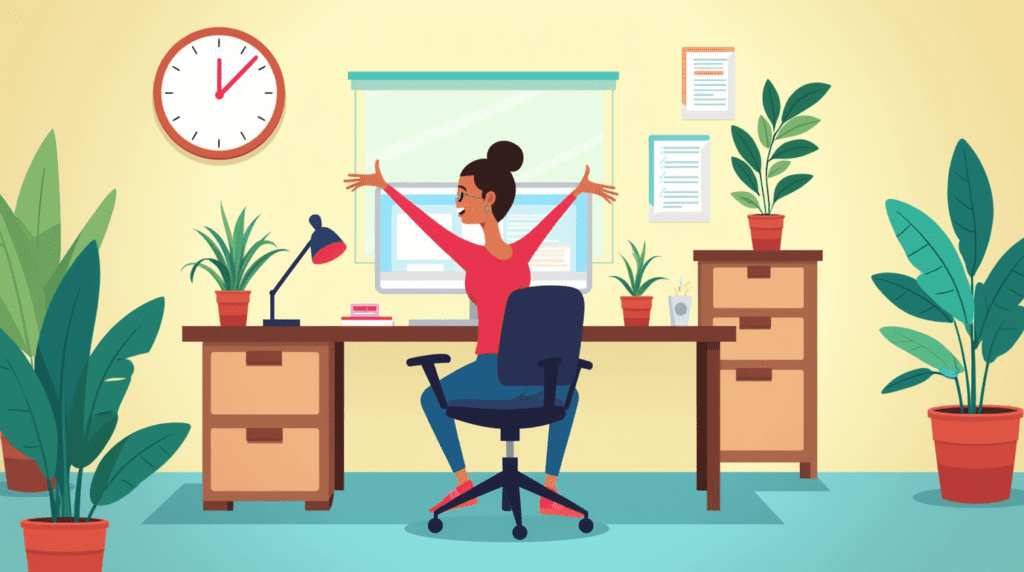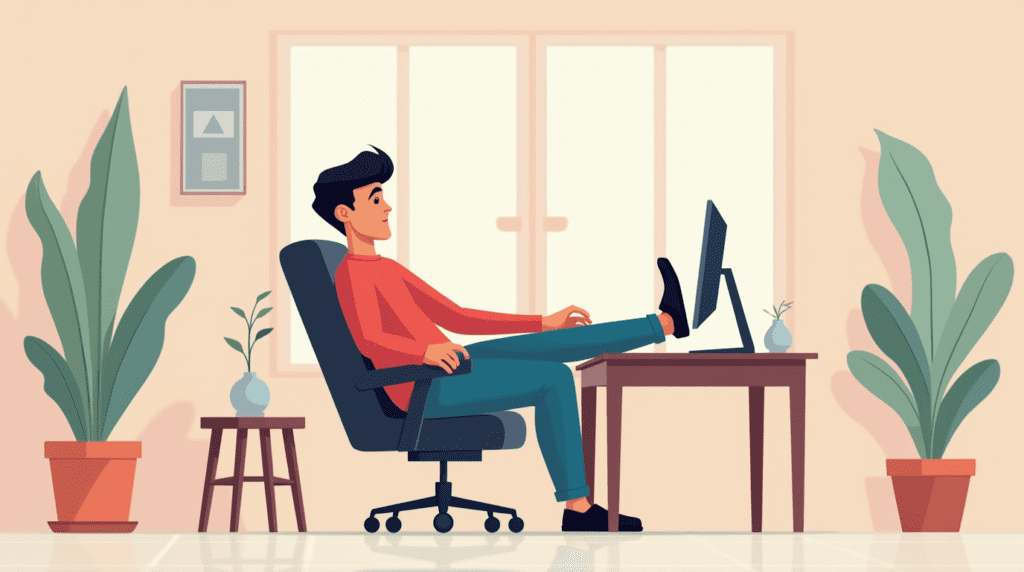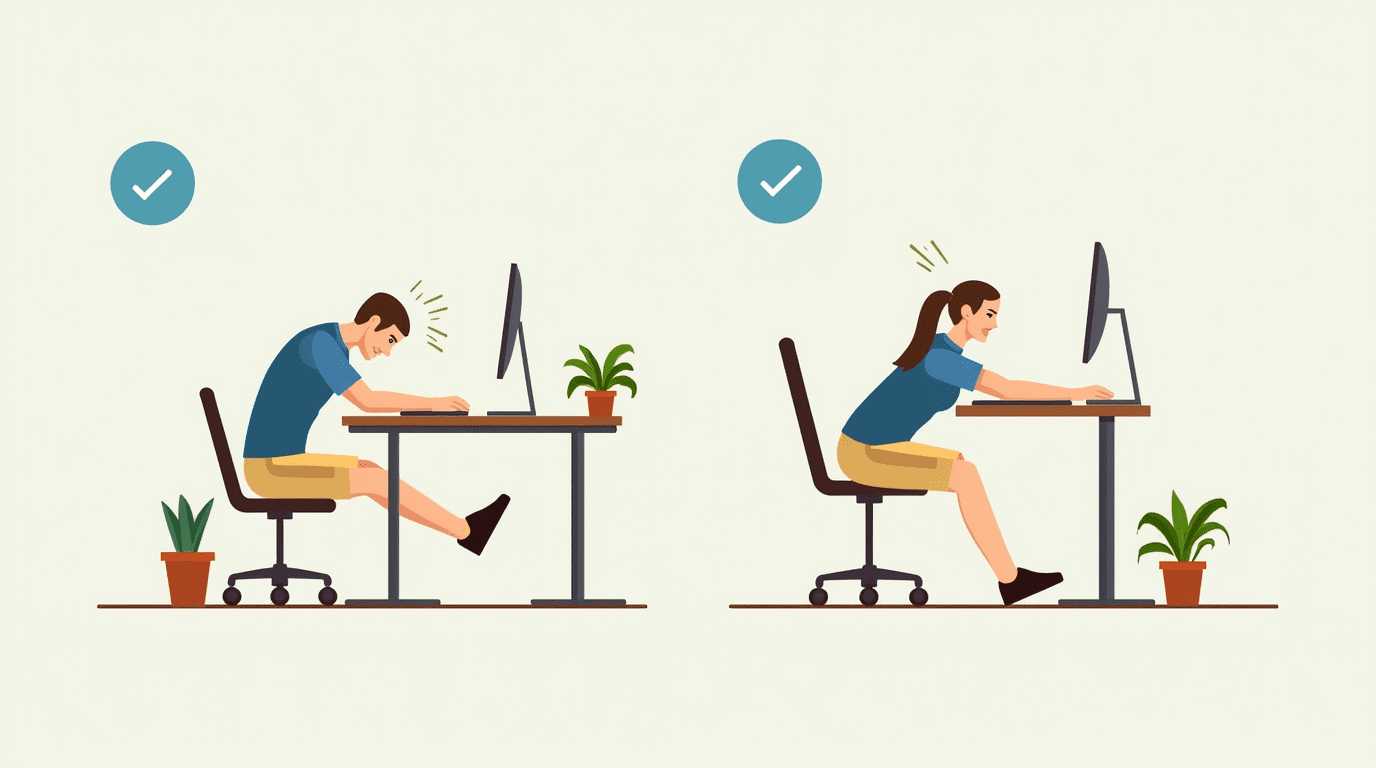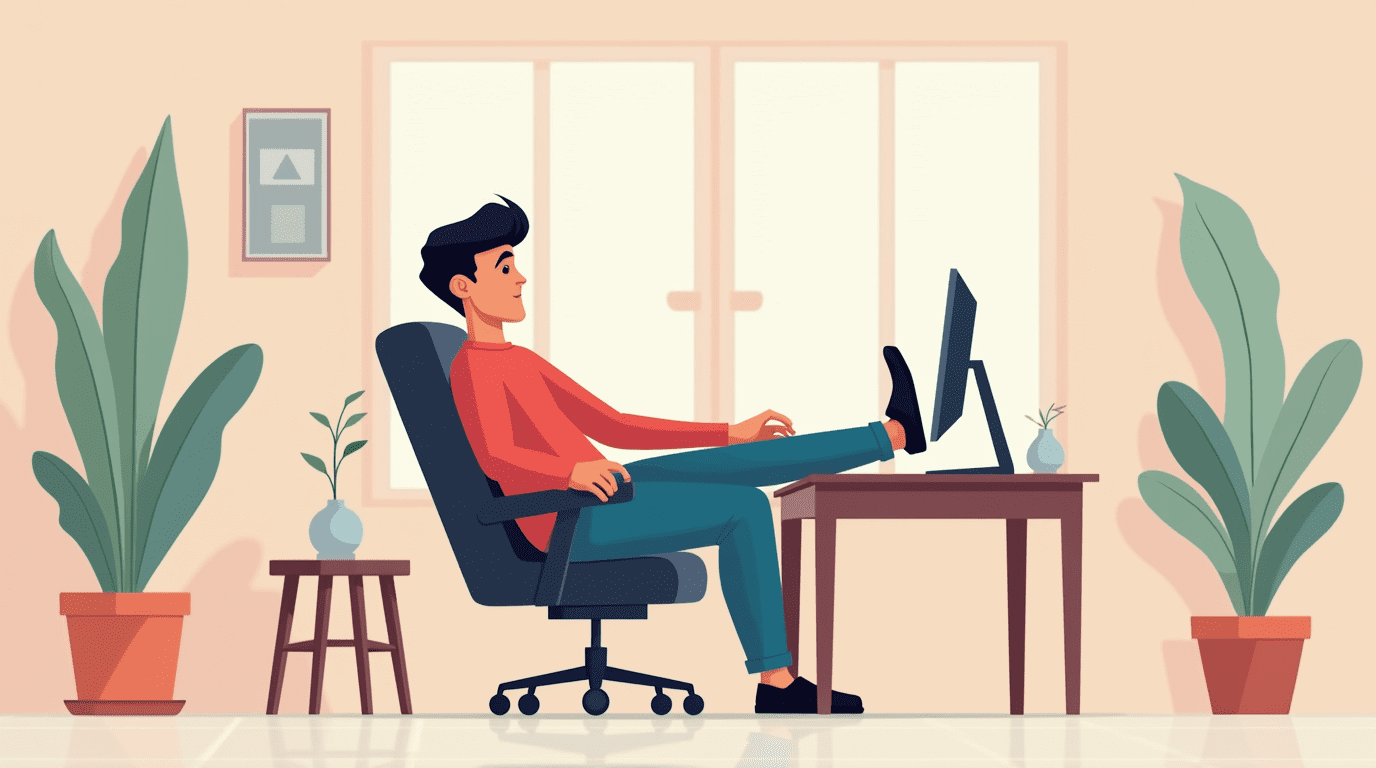Importance of Desk Stretches
Desk stretches play a vital role in enhancing the well-being of individuals who spend long hours in a seated position. Incorporating simple stretches throughout the workday can lead to significant health benefits.
Benefits of Stretching at Work
Stretching at work offers numerous advantages, particularly for desk workers. Research indicates that regular stretching can improve range of motion, enhance posture, and provide stress relief. Indeed, periodic workplace stretching can reduce pain by up to 72% and alleviate both physical and mental stress associated with the workday.
The following table outlines the specific benefits of stretching at work:
| Benefit | Description |
|---|---|
| Improved Range of Motion | Enhances flexibility, allowing for easier movement. |
| Enhanced Posture | Aids in maintaining a proper alignment while seated. |
| Pain Reduction | Can decrease discomfort by up to 72%. |
| Stress Relief | Alleviates physical and mental tension. |
Integrating stretching into the daily routine can contribute to a healthier work experience.
Addressing Sedentary Behavior
An analysis of job industry trends reveals that at least 8 in 10 American workers are considered “desk potatoes”. The sedentary nature of desk jobs can lead to various health issues, including back pain, neck strain, and reduced circulation. By performing quick desk stretches, employees can actively combat the negative effects of prolonged sitting.
The implementation of stretching programs in workplaces has shown promising outcomes, such as better range of motion, improved posture, and stress reduction. Moreover, rest breaks that incorporate stretching can effectively reduce discomfort without compromising productivity (Healthline). For more ideas on simple stretches to perform at your desk, refer to our article on easy desk stretches.
Incorporating desk stretches into the daily routine not only promotes physical health but also contributes to a more focused and productive work atmosphere. For targeted stretches that alleviate lower back pain, check our resource on desk stretches for lower back or for neck and shoulders, refer to desk stretches for neck and shoulders.
Quick Desk Stretches

Incorporating quick desk stretches into the workday can be highly beneficial for desk workers. Here are some key ways these stretches can help.
Stretching for Pain Reduction
Periodic stretching during the workday can significantly reduce discomfort. Research indicates that regular stretching at work can enhance range of motion and posture while providing essential stress relief. It has been reported that integrating workplace stretching may help lower pain levels by up to 72 percent and simultaneously alleviate both physical and mental stress associated with a typical workday.
| Benefit | Percentage Improvement |
|---|---|
| Pain Reduction | Up to 72% |
| Range of Motion | Improved |
| Posture Improvement | Achieved |
Stress Relief through Desk Stretches
Stretching at the desk not only eases physical discomfort but also plays a crucial role in managing stress levels. Periodic stretches throughout the day can thus help counteract mental fatigue. Studies have demonstrated that engaging in stretch sessions can effectively relieve both physical and emotional tension, leading to a more relaxed and productive work environment.
Stretching for Posture Improvement
Regular desk stretches contribute positively to posture. Reviews of workplace stretching programs indicate noteworthy improvements in range of motion and posture, as well as a reduction in stress levels. Those who incorporate stretching into their routine often experience benefits such as enhanced circulation, decreased muscle tension, increased energy levels, and improved focus. All these factors contribute to an overall boost in productivity and well-being for desk workers.
In summary, embracing quick desk stretches can vastly enhance the well-being of workers, allowing them to better manage pain, reduce stress, and improve posture in a work environment. For specific stretches, refer to our articles on desk stretches for neck and shoulders and desk stretches for lower back.
Stretching Techniques at the Desk

For desk workers, incorporating quick desk stretches into their daily routine can alleviate discomfort and enhance productivity. Below are effective techniques for stretching various body parts right at the workstation.
Hand and Forearm Stretches
Hand and forearm stretches are essential to prevent cramping and repetitive strain injuries. Here are some simple stretches:
- Make a Fist: Open the hand into a fist, then slide the fingertips up the palm.
- Wrist Bending: Gently bend the wrist from side to side.
- Wrist Rotation: Slowly rotate the wrist up and down.
- Grasp Stretch: Use one hand to grasp and bend the wrist of the other hand gently.
- Palm Lowering: Lower both wrists to the table with palms together.
Additionally, the “Wrist Stretch” involves pressing palms together in front of the chest and pushing the backs of the hands together for a reverse stretch. This process should be repeated five times.
| Stretch | Description |
|---|---|
| Make a Fist | Open and close your hand into a fist, sliding fingertips up the palm. |
| Wrist Bending | Gently bend wrist side to side. |
| Wrist Rotation | Slowly rotate wrist up and down. |
| Grasp Stretch | Bend wrist gently using the opposite hand. |
| Palm Lowering | Lower wrists to the table with palms together. |
Neck and Shoulder Stretches
Neck and shoulder stretches can ease tension and improve comfort during long work hours. Recommended stretches include:
- Shoulder Shrugs: Lift shoulders towards the ears and release.
- Head Glides: Gently glide the head from side to side.
- Neck Relaxers: Tilt head gently towards each shoulder.
- Shoulder Rolls: Roll shoulders forward and backward.
- Chest Stretches: Interlace fingers behind the back and lift to open the chest.
Stretching the chest, shoulders, upper back, and neck helps combat the impacts of prolonged sitting on the body.
| Stretch Type | Benefits |
|---|---|
| Shoulder Shrugs | Relieve tension in shoulders. |
| Head Glides | Loosen neck muscles. |
| Neck Relaxers | Reduce neck stiffness. |
| Shoulder Rolls | Increase mobility in shoulder joints. |
| Chest Stretches | Open chest area and improve posture. |
Back, Side, and Leg Stretches
To keep the back, sides, and legs relaxed and stretched, consider these exercises:
- Back/Side Stretches: Reach arms overhead and lean to one side.
- Back Curls: From a seated position, round the back and then reverse the arch.
- Ankle Flex: Flex and extend feet while seated to promote circulation.
- Leg Lifts: Lift legs straight up one at a time, holding briefly before lowering.
- Hip Stretches: Cross one leg over the other knee and gently press the knee away.
These stretches can alleviate tightness and discomfort caused by extended sitting.
| Stretch Category | Example Stretches |
|---|---|
| Back/Side | Reach arms and lean to the side. |
| Back Curls | Round back while seated. |
| Ankle Flex | Flex and point feet while seated. |
| Leg Lifts | Lift one leg at a time while sitting. |
| Hip Stretches | Cross leg and press knee away. |
Implementing these stretches throughout the workday can lead to decreased muscle tension and enhanced overall well-being for desk workers. For more easy stretches, check our article on easy desk stretches.
Incorporating Stretch Breaks
Taking regular stretch breaks is crucial for desk workers to alleviate discomfort, reduce stress, and maintain productivity. Here are strategies to effectively integrate stretching into the workday.
Effective Stretch Break Strategies
To reap the benefits of stretching, it is recommended to incorporate breaks every 30 to 45 minutes, as noted by Readers and Verywell Fit. Stretching for 5 to 10 minutes during these breaks can promote better circulation and reduce the risk of injury. Below is a table outlining beneficial stretch break strategies:
| Stretch Break Strategy | Recommended Frequency | Duration |
|---|---|---|
| Micro-Stretch Breaks | Every 30-45 minutes | 1-2 minutes |
| Full Stretch Breaks | Every hour | 5-10 minutes |
| Quick Walks | After every 2 hours | 5 minutes |
Workplace culture can support these practices by encouraging employees to take breaks and fostering an environment where movement is accepted. Simple actions like standing while on the phone or doing easy desk stretches can effectively integrate physical activity into the daily routine.
Utilizing Stretch Reminders
Employing reminders can be an effective way to ensure that stretch breaks are not overlooked. Tools like StretchClock offer hourly movement reminders and exercise videos tailored for desk workers. Additionally, setting alarms on personal devices or using calendar reminders can prompt individuals to take quick stretching breaks.
Incorporating stretch reminders can also be supported by visual cues in the workplace. Placing sticky notes around the desk with reminders to stretch can serve as effective prompts. It is important for workers to avoid pushing their bodies into extreme discomfort during stretches, allowing them to enjoy the process and reap health benefits over time. For specific stretches, refer to our articles on desk stretches for lower back and desk stretches for neck and shoulders.
By implementing these strategies and utilizing reminders, desk workers can maintain both physical and mental well-being throughout their workday.
Workplace Health Promotion
Impact of Stretch Programs
Implementing stretch programs in the workplace can significantly enhance the health and productivity of desk workers. An intervention study utilizing the “five-Business” stretch training program indicated that stretching exercises positively affect not only physical health but also mental health. The most substantial improvements were observed in mental well-being, suggesting that such programs can boost the health-related quality of life for office employees (Source).
Stretching exercises contribute to increased flexibility, decreased muscle stiffness, and reduced stress and pain levels. These factors are crucial, as the health-related quality of life (QoL) is closely linked to physical activity, musculoskeletal disorders (MSDs), stress, and mental health complaints. Thus, measuring these parameters can help evaluate the effectiveness of workplace health promotion programs (WHPPs).
Here is a summary of key benefits from implementing stretch programs:
| Study Findings | Impact |
|---|---|
| Improved flexibility and reduced muscle stiffness | Decreased pain and discomfort |
| Enhanced mental health aspects | Improved overall workplace morale |
| Reduction in MSDs and stress | Higher productivity |
Enhancing Worker Well-Being
Incorporating physical activity programs, including stretches, leads to a reduction in MSDs and stress among desk workers. Research indicates that firms aim to enhance employee health to cut costs and boost productivity. As a result, physical activity programs have become a common strategy in workplace health promotion.
A study conducted in Japan showed that introducing a sit-stand desk significantly decreased sitting time and alleviated neck and shoulder pain among participants (NCBI). This highlights the effectiveness of adjustable workstations in encouraging movement throughout the day and improving worker health.
Implementing quick desk stretches not only helps combat the adverse effects of prolonged sitting but also fosters a supportive work environment that prioritizes health and well-being. For additional resources, explore desk stretches for lower back and desk stretches for neck and shoulders to create a comprehensive stretching routine at work.
Case Studies and Research Findings
Research has consistently highlighted the importance of implementing quick desk stretches in the workplace. Various studies provide insights into the effectiveness of stretching and physical activity on desk workers’ health and productivity.
Study Results on Desk Stretches
A total of 313 office workers participated in a study utilizing the “five-Business” stretch training device, completing stretching routines twice a week for approximately 10 minutes over a 12-week period. The results demonstrated significant improvements in various health parameters, including:
| Health Parameter | Improvement |
|---|---|
| Mental sum score | Enhanced |
| Physical functioning | Improved |
| Bodily pain | Reduced |
| Vitality | Increased |
| Role limitations due to physical problems | Lessened |
| Mental health | Enhanced |
In addition to physical benefits, the study revealed that stretching exercises had a notable positive impact on mental health as well. The intervention led to increased health-related quality of life for office workers.
Workplace Desk Interventions
Another study conducted in Japan evaluated the impact of introducing sit-stand desks among desk workers. The findings indicated that the intervention group significantly decreased their sitting time at work (p = 0.002) and experienced a reduction in neck and shoulder pain (p = 0.001). These results underscored the effectiveness of sit-stand desks in mitigating the adverse effects of prolonged sitting and enhancing workers’ overall health and productivity.
The study also noted a substantial improvement in subjective health and vitality among workers using sit-stand desks, highlighting the broader benefits of ergonomic interventions in the workplace.
Physical Activity for Work Engagement
Further investigations into the relationship between physical activity and work engagement have shown encouraging results. Employees who participated in physical exercise at least once a week during work reported higher levels of engagement and productivity. This emphasizes the correlation between regular physical activity and enhanced work engagement, illustrating the significance of incorporating stretching and movement into daily routines in office settings (NCBI).
These studies collectively demonstrate the importance of quick desk stretches and physical activity as essential components of workplace health strategies. For more specific exercises that can be easily integrated into the workday, consider exploring desk stretches for lower back, desk stretches for neck and shoulders, and easy desk stretches.



